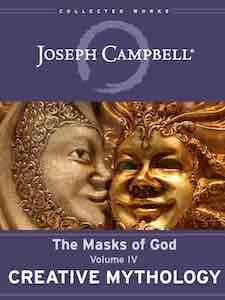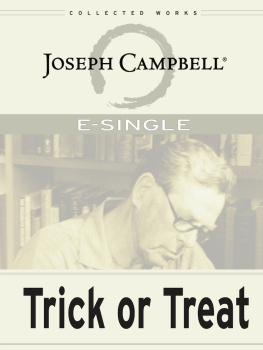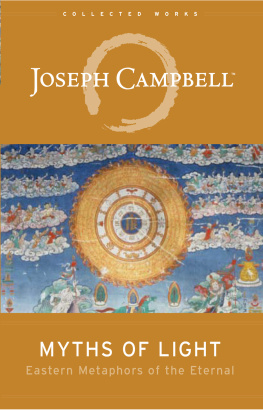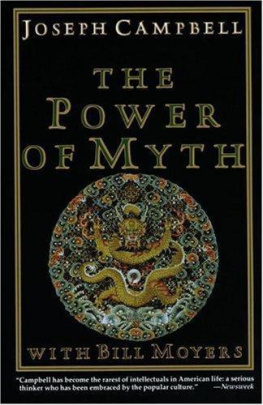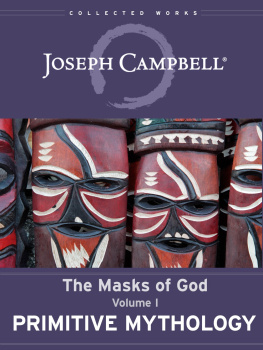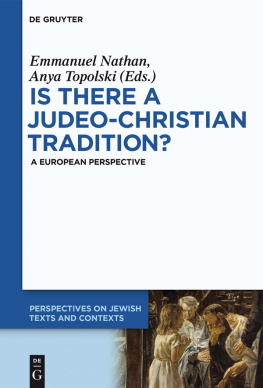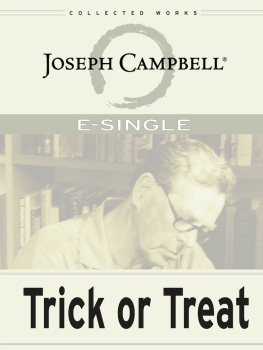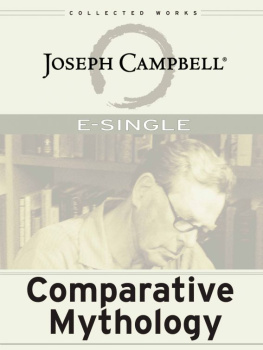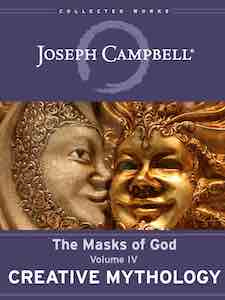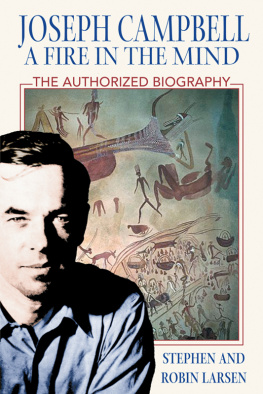On the Foundations of Morality, Smtliche Werke, Arthur Schopenhauer (Verlag der Cottaschen Buchhandlung, 18951898), p. 293.
Ibid.
Op. cit., p. 254.
Op. cit., p. 293.
Joseph Campbell, The Inner Reaches of Outer Space: Metaphor as Myth and as Religion (Novato, California: New World Library, 2002), p. 84.
Chapter I
This material on the meaning and function of myth is drawn from Joseph Campbells lectures entitled Metaphor as Myth and as Religion presented at the Jung Institute in San Francisco (tapes L916, L917, L918 in the Joseph Campbell Foundations audio archives), in 1985. These were augmented from the notes of the editor (Eugene Kennedy) from an interview with Campbell on March 4, 1986, in Honolulu, and later published in the Forum section of the National Catholic Reporter. The occasion of the interview was the forthcoming publication of The Inner Reaches of Outer Space: Metaphor as Myth and as Religion, in which a fuller treatment of this and related subjects may be found. The material on metaphor as the native tongue of myth is drawn from four lectures presented at the University of Beloit, Beloit, Wisconsin, in January 1969.
Joseph Campbell. Historical Atlas of World Mythology, Volume I: The Way of the Animal Powers, (New York: Alfred van der Marck Editions, 1983).
Chapter II
This material has been drawn from lectures delivered by Campbell entitled Symbolism and Mystical Experience (tapes L117, L121, L122, L124, L126, L127) presented at Wainwright House between October 3 and December 12, 1966. Other material has been taken from lectures on Mystical Experience and the Heros Journey, given at the Esalen Institute in Big Sur, California (tapes L179, L180), on October 13 and October 14, 1967. Some material was incorporated from his Way of Contemplation, given on October 15, 1967, at the same institute. A few quotations have also been added from Campbells participation in a panel discussion, What Is Spirituality? (tape L835) recorded on October 10, 1983, at Esalen. A small amount of material is taken from The Need and Importance of Rites (tape L90), a lecture delivered by Campbell at the Cooper Union in New York City on January 20, 1964. For a fuller exposition of this theme, see Myths to Live By (New York: Joseph Campbell Foundation, 2011). For a fuller treatment of the hero themes, see The Hero with a Thousand Faces (Novato, California: New World Library, third edition, 2008). See also Campbells extended treatment of The Metaphysical-Mystical Prospect, in The Masks of God: Creative Mythology (New York: Joseph Campbell Foundation, 2016). Campbells references to Wittgenstein on the mystical (Op. cit., p. 675) are particularly relevant for those interested in the both the sources and the breadth of Campbells intellectual inquiry. The Christian mystical tradition is discussed at length (p. 588 ff.) in the section on The New Universe.
Erwin Schrdinger. My View of the World, (Cambridge: Cambridge University Press, 1964), p. 22.
Chapter III
Some of this chapter is based on Metaphor as Myth and as Religion (tape L918) presented at the Jung Institute, San Francisco, 1985. Additional material was taken from a series of lectures entitled The Experience of Mystery presented at the Theatre of the Open Eye, in New York City on April 23 and April 24, 1983. Most of this chapter is based on Man and Myth: Imagination and Its Relation to Theological Enquiry, ed. Malcolm Spicer, Department of Theological Studies, Loyola of Montreal (Montreal: Editions Declee & Cie., 1973).
A fuller discussion of the Kantian concept of the a priori forms of sensibility and the philosophy of my may be found in The Masks of God: Oriental Mythology (New York: Joseph Campbell Foundation, 2014).
See The Inner Reaches of Outer Space and Joseph Campbell, Pathways to Bliss: Mythology and Personal Transformation, edited by David Kudler (Novato, California: New World Library, 2004) for a fuller exploration of this idea.
For an extended discussion of the origin of the Gospel of Thomas, see The Masks of God: Occidental Mythology (Viking Press, 1964), p. 363.
The Waste Land, Collected Poems 19091962, T.S. Eliot (Harcourt Brace and World, 1963).
Franz Pfeiffer. Meister Eckhart, trans. C. de B. Evans, 2 vols. (John W. Watkins, 1947), sermon 98.
Chapter IV
A portion of this chapter derives from the lecture Metaphor as Myth and as Religion (tape L918) presented at the Jung Institute, San Francisco, in 1985. This chapter is also rooted in sections of Man and Myth: Imagination and Its Relation to Theological Enquiry, cited above. This was in turn based on the lecture Imagination and Its Relation to Theological Enquiry, presented at Loyola University, Montreal, Canada, on October 17, 1972.
James Joyce. A Portrait of the Artist as a Young Man (Jonathan Cape, Ltd., 1916. Viking Compass Edition, 1964), pp. 232233.
This is Pope Boniface viii s dogma, stated in his bull, Unam Sanctam (single holiness). It translates, No salvation outside the Church!
Chapter V
Much of this chapter is conflated from two lectures with the same theme, both entitled Genesis and Exodus as History and Myth. The first was given at Hillel Jewish Center in Los Angeles, California, on October 17, 1985 (tape L858). The second was given at the Theatre of the Open Eye, New York City, on December 10, 1985 (2 tapes, L859). Fuller treatments of some of these themes, in a slightly different context, may be found in Campbells The Masks of God: Creative Mythology, as, for example, in the third chapter, The Word Behind Words..
Die Daten der Genesis, Knigliche Gesellschaft der Wissenschaften zu Gttingen, Nachrichten 10, Julius (Jules) Oppert (1877), pp. 20127. See also Joseph Campbell, The Mystery Number of the Goddess from The Mythic Dimension, edited by Antony Van Couvering (Novato, California: New World Library, 2009) for a fuller exploration of the numerology of the spirit and of the dual nature of the narrative in Genesis.
Thomas Mann. Joseph and his Brothers, trans. H. T. Lowe-Porter (New York: Alfred Knopf, 1934).
Chapter VI
A large part of this chapter is taken from Archetypes of the Christ Legend (L337), lectures at the Mann Ranch Seminar on April 3, 1971. Other material derives from the lecture, Symbols of the Christian Faith (L407), given at the Blaisdell Institute in Claremont, California, in April 1972. Further sections of this chapter were taken from The Vocabulary of the Christian Faith: When Terms Have Lost Their Mythic Power, given at Trinity Presbyterian Church, Atlanta, Georgia, on May 31, 1971. Some of the material on the symbolism of the cross is based on Campbells article The Interpretation of Symbolic Forms from The Mythic Dimension. Further treatments of some of these themes may be found in The Masks of God: Occidental Mythology. Biblical names were checked in and interpolated brief descriptions are based on John L. McKenzie. Dictionary of the Bible (New York: Macmillan Publishing Company, 1965).
Hvaml 139142, The Poetic Edda, translated by Henry Adams Bellows (American-Scandinavian Foundation, Oxford University Press, 1923), pp. 6061.
Questions
These questions and answers are edited versions of actual question sessions following the lectures listed above.

